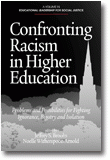
Confronting Racism in Higher Education
Problems and Possibilities for Fighting Ignorance, Bigotry and Isolation
Edited by:
Jeffrey S. Brooks, University of Idaho
Noelle Witherspoon-Arnold, University of Missouri-Columbia
A volume in the series: Educational Leadership for Social Justice. Editor(s): Jeffrey S. Brooks, Curtin University. Denise E. Armstrong, Brock University. Ira Bogotch, Florida Atlantic University. Sandra Harris, Lamar University. Whitney Sherman Newcomb, Virginia Commonwealth University. George Theoharis, Syracuse University.
Published 2013
Racism and ignorance churn on college campuses as surely as they do in society at large. Over the past fifteen years there have been many discussions regarding racism and higher education. Some of these focus on formal policies and dynamics such as Affirmative Action or The Dream Act, while many more discussions are happening in classrooms, dorm rooms and in campus communities. Of course, corollary to these conversations, some of which are generative and some of which are degenerative, is a deafening silence around how individuals and institutions can actually understand, engage and change issues related to racism in higher education. This lack of dialogue and action speaks volumes about individuals and organizations, and suggests a complicit acceptance, tolerance or even support for institutional and individual racism. There is much work to be done if we are to improve the situation around race and race relation in institutions of higher education.
There is still much work to be done in unpacking and addressing the educational realities of those who are economically, socially, and politically underserved and oppressed by implicit and overt racism. These realities manifest in ways such as lack of access to and within higher education, in equitable outcomes and in a disparity of the quality of education as a student matriculates through the system. While there are occasional diversity and inclusion efforts made in higher education, institutions still largely address them as quotas, and not as paradigmatic changes. This focus on “counting toward equity rather” than “creating a culture of equity” is basically a form of white privilege that allows administrators and policymakers to show incremental “progress” and avoid more substantive action toward real equity that changes the culture(s) of institutions with longstanding racial histories that marginalize some and privilege others.
Issues in higher education are still raced from white perspectives and suffer from a view that race and racism occur in a vacuum. Some literature suggests that racism begins very early in the student experience and continues all the way to college (Berlak & Moyenda). This mis-education, mislabeling and mistreatment based on race often develops as early as five to ten years old and “follows” them to postgraduate education and beyond.
CONTENTS
Acknowledgements. Confronting Racism in Higher Education. Problems and Possibilities for Fighting Ignorance, Bigotry and Isolation, Noelle Witherspoon Arnold and Jeffrey S. Brooks. Examining the Blockages of Race-Related Conversations in the Classroom: From Recognition to Action, Sarah Diem and Bradley W. Carpenter. Persistence is Chess, Not Checkers: A Counterstory on the Lives and Strategies of Six African American Administrators at One Predominantly White Institution, Brandon L. Wolfe. Combat in the Academy: Racial Battle Fatigue, Role Strain, and African American Faculty at Public Community Colleges, Tamara Nichele Stevenson. Critical Race Theory and College Readiness: A Review of the Literature, Chad Everett Kee. An Overview of the History, Research, and Culture of Historically Black Greek Letter Organizations, Andre Brown. Legal and Educational Foundations in Critical Race Theory, Evelyn Y. Young. Critical Race Theory and Its Viability as a Tool for Critiquing Current Theoretical Leadership: Constructions of African American Women, Collette Madeleine Bloom. Re(thinking) Race: Positioning Multiracial Representations within Critical Pedagogy, Claire Peinado Fraczek. Who’s Zoomin’ Who?: A Critical Race Analysis of Florida’s Public High School Graduates, Terri Watson and Jennifer Sughrue. Neither Latino nor White Enough: Educational Experiences of Meso Hispanic, Meso American, Urban, and Suburban Public High School Students, Paula Marie Gallegos. About the Contributors.
-
Paperback9781623961565
Web price: $45.04 (Reg. 52.99)
-
Hardcover9781623961572
Web price: $80.74 (Reg. 94.99)
- eBook9781623961589

- EDU000000 - EDUCATION: General
- EDU032000 - EDUCATION: Leadership
- EDU029040 - EDUCATION: TEACHING METHODS & MATERIALS: Social Science
-
 Adult Intentions, Student Perceptions
How Restorative Justice is Used in Schools to Control and to Engage
Adult Intentions, Student Perceptions
How Restorative Justice is Used in Schools to Control and to Engage
-
 Crossing the Bridge of the Digital Divide
A Walk with Global Leaders
Crossing the Bridge of the Digital Divide
A Walk with Global Leaders
-
 Dear Gay, Lesbian, Bisexual, And Transgender Teacher
Letters Of Advice To Help You Find Your Way
Dear Gay, Lesbian, Bisexual, And Transgender Teacher
Letters Of Advice To Help You Find Your Way
-
 Envisioning a Critical Race Praxis in K-12 Education Through Counter-Storytelling
Envisioning a Critical Race Praxis in K-12 Education Through Counter-Storytelling
-
 Restorative Practice Meets Social Justice
Un-Silencing the Voices of "At-Promise" Student Populations
Restorative Practice Meets Social Justice
Un-Silencing the Voices of "At-Promise" Student Populations
-
 School Leadership in a Diverse Society
Helping Schools Prepare all Students for Success (2nd Edition)
School Leadership in a Diverse Society
Helping Schools Prepare all Students for Success (2nd Edition)
-
 Within Reach
Providing Universal Access to the Four Pillars of Literacy
Within Reach
Providing Universal Access to the Four Pillars of Literacy

